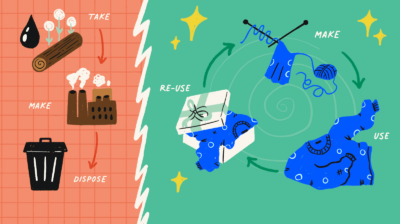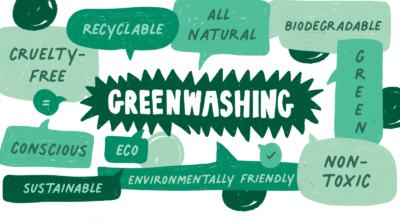How to make more sustainable clothing choices
Find out how you can create a more sustainable wardrobe, from taking care of the clothes you own to buying secondhand clothes.


So you’re interested in sustainable living but not quite sure how to start? Clothing is a great place to begin since it’s something you can put a small amount of effort into every day. Moving towards a greener, more sustainable wardrobe is a really important step we can take as individuals to lessen the impact the fashion industry is having on our planet.
Since the Industrial Revolution and the invention of the sewing machine, the fashion industry has grown significantly. In the 1990s, what is now known as the ‘Fast Fashion’ model was embraced by clothing manufacturers. The fast fashion industry rapidly produces a large amount of trending clothing. It is often made of cheap, synthetic materials and of poor quality to keep costs low. Fast fashion is also often made in factories where workers are exploited, by being made work for very little money in unsafe conditions. Fast fashion thrives off our ‘take, make, waste’ economic model and quickly fading high street trends. This means a lot of clothes end up in landfills due to being poor quality or because they are no longer in fashion after being a short-lived trend.
How do I start being sustainable?
Having a more sustainable wardrobe doesn’t mean having to spend lots of money. Actually, one of the most immediate sustainable actions you can take is to buy less, and there are lots of ways to take part in sustainable fashion without spending money, you could even save money. Find out more about sustainable fashion on a budget.
Washing clothes sustainably
The first step you can take to be more sustainable when it comes to your clothes is to wash them less often and at lower temperatures.
Washing at 30 degrees or under can save energy and make your clothes last longer – especially delicate fast-fashion pieces that were not made to last. Just separate these items from things like sheets and towels that need to be washed at 60 degrees for hygiene reasons.
Ways to cut down on washing:
- Airing out clothes on a washing line
- Steaming them
- Spot cleaning
- Spraying them with a water and alcohol solution
Washing less also keeps your clothes in good condition. You can try out environmentally friendly detergents or solutions like eco eggs and soap nuts if you want to take things a step further.
There are also reusable washing bags you can buy to put your clothes into when you wash them. They act as a filter, catching microplastics which you can then remove, put into a closed container and put in your general waste – as they cannot be recycled.
If you don’t have immediate access to these laundry items, taking a step like washing your clothes less is still a great place to start making a difference.
Swap, donate or sell your clothes
There are lots of options for your outgrown or unwanted clothes besides throwing them in the bin. You could consider giving them to a friend, selling them on or donating them to a charity. The amount of clothes we use and throw away is a major issue for the environment. Ireland alone sends 63,000 tonnes of textiles to landfill every year and globally one garbage truck full of textile waste is landfilled or incinerated every second. At present, less than 1% of clothes are recycled for use in the manufacture of new clothing, according to the Ellen MacArthur Foundation.
Repair or reuse your clothes
If you have clothes that are ripped or worn, consider learning simple sewing techniques so you can patch up elbows, darn a hole or reattach straps at home. If it’s too big a job to take on yourself you can try your local alterations shop for textiles or a cobbler to have shoes resoled.
You can also explore ways to reuse old clothes. There are loads of interesting and achievable upcycling options for your unwanted items. Whatever level your sewing and making skills are at, there are plenty of tutorials online for you to follow and get inspiration from. For example, if you have old socks or things that are past the point of being wearable, you can try reusing them as cleaning cloths or cut the fabric into strips and use them to make handmade rugs or plant holders. Or you can take on more complicated projects like turning your old pair of jeans into a skirt or combining an old shirt with a T-shirt to make a new dress, you can even use your old jumpers to make matching mittens and hats for the winter.
Can you recycle clothes?
If you’re unable to repair or reuse old clothes, then you could look into recycling. Some clothing stores allow you to bring back their old clothes to be recycled. There are also a few clothing recycling centres in Ireland and clothes banks like Clothes Pod. The only issue with clothing banks is that they often export clothes overseas to be resold or recycled, so it is difficult to assess how sustainable this option is.
In any case, this should be a last resort as a lot of recycled clothing is made into lower-value products like insulation, but it is still better than throwing them in the bin.
Buy Less
It can take a few weeks for natural fibres like cotton and linen to decompose, but between 20 and 200 years for polyester. If you’re conscious of the impact of your clothes on the environment you’re likely already thinking about how you can use what you have to its maximum potential. Read more about sustainable materials.
Buying fewer items of clothing is one of the best things we can do to reduce the impact of our wardrobe on the planet. As well as reducing the market demand and ultimately slowing down the volume of clothing produced, by buying less you will naturally be using what you already own, extending the lifespan of the clothes already in your wardrobe. Limiting the amount of new purchases you make will also help you think more creatively about the way you wear the clothes you already have, styling them and combining them in new and interesting ways.
If you are buying something new, here are some questions to ask yourself before you make your purchase:
- Do I really need this?
- Do I already have something similar?
- Will I wear it more than 30 times?
- What is it made of?
- Will it be durable and last a long time?
- Who made it and am I happy to support this brand?
- What are the care instructions and will it be easy to wash?
Choose second hand clothes
Buying second hand clothes is a great way to stop clothes going to landfill, giving them a second life and extending their lifespan helps reduce their carbon footprint. It’s often much cheaper to buy good quality pieces like coats and jeans second hand. And if you are lucky you can end up with some really unique items of clothing.
Charity shops are a great way to find affordable second hand pieces. If you find something that isn’t quite right, you can have it repaired or adjusted at your local alterations shop using some of the money you saved, or you can try to adjust it yourself. Charity shops usually sell things like jewellery, books and homeware too. Shopping at charity shops is a way to help the planet while supporting a good cause.
If you have a slightly higher budget, vintage shops and online vintage boutiques can also be a great place to find sustainable clothes. You can find pieces with character that have already lasted through other people’s wardrobe, so they’ll certainly last through yours.
Go for sustainable materials
Man-made materials or synthetic materials can be toxic to the environment and often take much longer to decompose/biodegrade. Another issue with clothes made of these synthetic materials like polyester and nylon is that they release tiny particles called microfibres when you wash them. Washing synthetic clothes is responsible for 35% of microplastics in our environment. These small particles can pollute waterways and end up in our food when they get eaten by the animals we consume. It’s okay if you own things made of synthetic materials, but washing them less can help to minimise their impact on the environment. There are also bags you can buy to put synthetic materials inside while washing them which to collect the microplastics, which can then be thrown into the bin.
Some natural fibres can also have a very wasteful production process. It takes around 2,700 litres of fresh water to produce one cotton t-shirt. Cotton requires a lot of pesticides to grow which negatively impacts people who grow the cotton as well as the local environment planet. This is why it’s important to always use the clothes you have to their maximum potential and shop second hand.
However, sometimes buying new clothes is the most accessible and affordable option. If you are buying new, try and choose single fibre materials as these will have more recycling options at their end of life or look for sustainable materials like tencel, or organic fairtrade cottons.
Be active
Not all of the above are accessible to everyone. If you can’t make all of the changes to your wardrobe that you would like there are other ways to help. Educating your friends and family on the topic of clothing waste and the fashion industry’s impact on the environment is a way to be actively sustainable. By raising awareness you will be raising the possibility of change It will help inform the people that have the means to make changes. Reading and watching documentaries on this topic can help with your own knowledge too.
Cover image by Cathy Hogan






